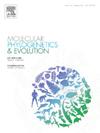宏基因组分析揭示了沃尔巴克氏体的三个超群在一个属的羽毛食虱(Penenirmus)。
IF 3.6
1区 生物学
Q2 BIOCHEMISTRY & MOLECULAR BIOLOGY
引用次数: 0
摘要
营养有限的昆虫通常含有细菌内共生体,以补充它们的营养需求。然而,并非所有细菌和昆虫之间的相互作用都是互利的。沃尔巴克氏体是一种细菌属,它经常对许多节肢动物宿主造成细胞质不相容性和其他生殖寄生效应。然而,在线虫和一些昆虫中,沃尔巴克氏体是一种营养互惠主义者。沃尔巴克氏体的一个谱系与共生菌株密切相关,此前已在寄生虱子中被发现,包括专门以羽毛为食的Penenirmus虱属(Ischnocera)。在这项研究中,我们使用基因组解析的宏基因组学来研究沃尔巴克氏体在Penenirmus属中的多样性,重点关注与宿主长期关联的证据,这可能表明一种互惠关系。对来自沃尔巴克氏体的100多个基因的系统基因组分析提供了该细菌属的良好解决系统发育。在不同种类的鼠属(Penenirmus)中,来自这些昆虫的沃尔巴克氏体基因组测序显示存在三个不同的超群(B、F和V)。超级V群以前没有从虱子中发现过。系统发育分析显示沃尔巴克氏体和虱子树之间有显著的一致性,尽管一些分支显示不一致。来自超群F和B的Wolbachia Penenirmus物种通过具有较长的分支,与虱子宿主的共进化一致性以及相对较小的基因组大小显示出潜在的互惠关系。长支吸引可能影响两个沃尔巴克氏体谱系的系统发育位置,但其他所有样本的相对位置相对稳定。本文章由计算机程序翻译,如有差异,请以英文原文为准。

Metagenomic analyses reveal three supergroups of Wolbachia in a single genus of feather-feeding lice (Penenirmus)
Insects with nutritionally limited diets often harbor bacterial endosymbionts that supplement their nutritional requirements. However, not all interactions between bacteria and insects are mutually beneficial. Wolbachia is a genus of bacteria that frequently causes cytoplasmic incompatibility and other reproductive parasitic effects on many of its arthropod hosts. In nematodes and some insects, however, Wolbachia is a nutritional mutualist. A lineage of Wolbachia closely related to mutualist strains has previously been identified in parasitic lice, including the louse genus Penenirmus (Ischnocera), which specializes in feeding on feathers. In this study, we used genome-resolved metagenomics to examine the diversity of Wolbachia across the genus Penenirmus, with a focus on evidence of long term associations with their hosts, which could indicate a mutualistic relationship. Phylogenomic analysis of over 100 genes from Wolbachia provided a well-resolved phylogeny of this bacterial genus. Across diverse species of the louse genus Penenirmus, genome-resolved metagenomic assemblies of Wolbachia from these insects revealed the presence of three different supergroups (B, F, and V). Supergroup V had not previously been known from lice. Cophylogenetic analysis revealed significant congruence between the Wolbachia and louse trees, although some branches showed incongruence.
The Wolbachia in Penenirmus species from supergroups F and B showed evidence of potential mutualism by having long branches, cophylogenetic congruence with their louse hosts, and comparatively smaller genome sizes. Long branch attraction may be affecting the phylogenetic position of two lineages of Wolbachia, but the relative position of all other samples was comparatively stable.
求助全文
通过发布文献求助,成功后即可免费获取论文全文。
去求助
来源期刊
CiteScore
7.50
自引率
7.30%
发文量
249
审稿时长
7.5 months
期刊介绍:
Molecular Phylogenetics and Evolution is dedicated to bringing Darwin''s dream within grasp - to "have fairly true genealogical trees of each great kingdom of Nature." The journal provides a forum for molecular studies that advance our understanding of phylogeny and evolution, further the development of phylogenetically more accurate taxonomic classifications, and ultimately bring a unified classification for all the ramifying lines of life. Phylogeographic studies will be considered for publication if they offer EXCEPTIONAL theoretical or empirical advances.

 求助内容:
求助内容: 应助结果提醒方式:
应助结果提醒方式:


